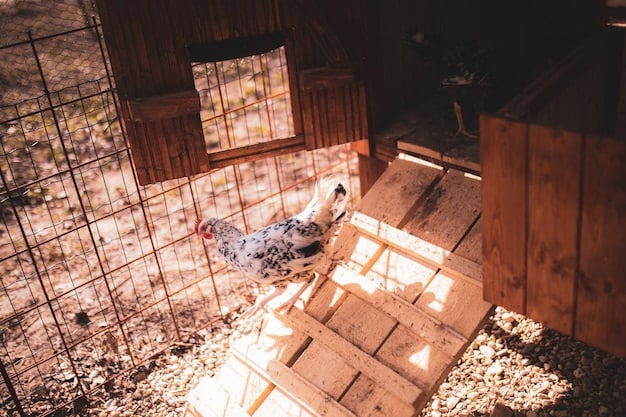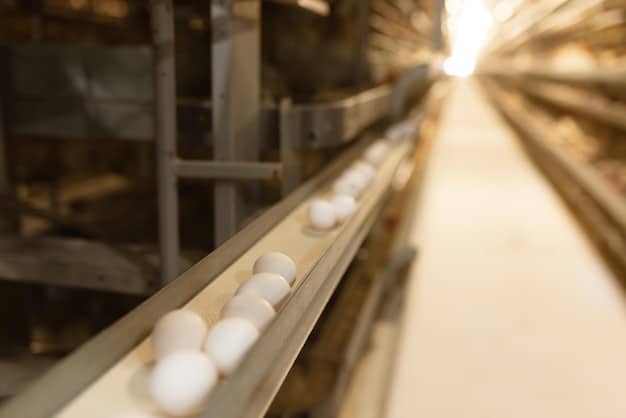Build a Chicken Coop: Beginner’s Step-by-Step Guide for Fresh Eggs

Building a chicken coop is a rewarding DIY project that allows you to provide a safe and comfortable home for your chickens, ensuring a steady supply of fresh eggs right from your backyard. This step-by-step guide is designed for beginners, offering clear instructions and helpful tips to create a functional and attractive coop.
Ready to enjoy fresh eggs from your own backyard? This guide provides a step-by-step approach to build a chicken coop for fresh eggs: a step-by-step guide for beginners. Follow these instructions to create the perfect home for your feathered friends.
Why Build Your Own Chicken Coop?
Building your own chicken coop offers numerous benefits, from cost savings to customization. Beyond the economic advantages, constructing a coop yourself allows you to tailor the space to your specific needs and preferences, ensuring a comfortable and secure environment for your chickens.
Here are a few key reasons to consider building your own coop:
Cost Savings
Purchasing a pre-built chicken coop can be expensive. By building your own, you can save a significant amount of money on materials and labor.
Customization
You can design the coop to perfectly fit your backyard space and the number of chickens you plan to keep. This allows you to optimize the layout and ensure your chickens have ample room to roam and roost.
Quality Control
Building your own coop allows you to choose high-quality materials and ensure that the construction is sturdy and durable. This can extend the lifespan of the coop and provide better protection for your chickens.
- Tailored Design: Customize the size, layout, and features to match your flock’s needs.
- Material Selection: Choose durable and safe materials for a long-lasting coop.
- DIY Satisfaction: Enjoy the sense of accomplishment from building a functional structure yourself.
Ultimately, building your own chicken coop is a rewarding project that combines practicality and creativity. By designing and constructing the coop yourself, you can create a safe, comfortable, and cost-effective home for your chickens, ensuring years of fresh eggs and backyard enjoyment.

Planning Your Chicken Coop
Before you start building, careful planning is essential to ensure your coop meets your needs and provides a safe and comfortable environment for your chickens. Consider factors such as the number of chickens, available space, local climate, and your budget.
Here are some key considerations for planning your build a chicken coop for fresh eggs: a step-by-step guide for beginners :
Size and Space Requirements
The size of your coop should be determined by the number of chickens you plan to keep. A general rule of thumb is to provide at least 4 square feet of coop space per chicken and 8-10 square feet of run space per chicken. This ensures they have enough room to move around comfortably.
Location and Climate
Choose a location for your coop that is sheltered from strong winds and direct sunlight, and that provides good drainage. Consider the local climate and design the coop to provide adequate ventilation in hot weather and insulation in cold weather.
Coop Design and Features
Consider the design and features of your coop, such as the size and number of nesting boxes, roosting bars, and access doors. Plan for easy cleaning and maintenance to keep the coop sanitary and prevent the spread of disease.
- Flock Size: Determine how many chickens you plan to house.
- Space Availability: Measure your backyard to ensure the coop fits comfortably.
- Climate Considerations: Design the coop to withstand local weather conditions.
By carefully planning your chicken coop, you can ensure that it meets your needs and provides a safe and comfortable home for your chickens. This will help you enjoy fresh eggs and a thriving backyard flock for years to come.
Gathering Your Materials and Tools
With your plans in hand, the next step is to gather the necessary materials and tools for your build a chicken coop for fresh eggs: a step-by-step guide for beginners. Having everything on hand before you start construction will streamline the process and prevent unnecessary delays.
Here’s a list of common materials and tools you’ll need:
Lumber and Hardware
You’ll need lumber for framing, siding, and roofing. Treated lumber is recommended for ground contact to prevent rot. You’ll also need nails, screws, hinges, and latches to assemble the coop.
Wire Mesh and Fencing
Wire mesh or fencing is essential for creating a secure run that protects your chickens from predators. Choose a mesh size that is small enough to prevent predators from entering the coop.
Roofing Materials
Choose roofing materials that are durable and weather-resistant, such as asphalt shingles, metal roofing, or corrugated plastic. Ensure the roof is properly sloped to prevent water accumulation.
Having all the necessary materials and tools on hand before you start construction will make the process much smoother and more efficient. This will help you build a chicken coop for fresh eggs: a step-by-step guide for beginners safely and ensure that it is sturdy and durable.
- Lumber: Pressure-treated wood for the frame, untreated for interior components.
- Hardware Cloth: Secure the coop and run against predators.
- Tools: Saw, drill, hammer, measuring tape, and safety glasses.
Constructing the Coop Frame
With your materials and tools ready, you can begin constructing the frame of your chicken coop. The frame is the foundation of the entire structure, so it’s important to ensure that it is sturdy and square.
Follow these steps to build the coop frame:
Cutting the Lumber
Cut the lumber according to your plans, making sure to measure accurately and use a saw that is appropriate for the size and type of wood you are cutting.
Assembling the Frame
Assemble the frame using nails or screws, making sure that all corners are square and that the frame is level. Use corner braces to reinforce the joints and prevent the frame from racking.
Adding the Base and Roof Supports
Add a base to the frame using treated lumber to protect the coop from ground moisture. Install roof supports to provide a sturdy base for your roofing materials.
Creating a sturdy frame is essential for the durability and longevity of your chicken coop. This will help protect your chickens and ensure that your coop lasts for years to come.
- Foundation: Start with a level and solid base.
- Wall Framing: Ensure all corners are square for a stable structure.
- Roof Supports: Properly spaced to support the roofing material.

Adding the Walls, Roof, and Nesting Boxes
Once the frame is complete, you can add the walls, roof, and nesting boxes to your chicken coop. These components provide protection from the elements, privacy for your chickens, and a place for them to lay their eggs.
Here’s how to proceed with your build a chicken coop for fresh eggs: a step-by-step guide for beginners:
Installing the Walls
Attach siding to the frame using nails or screws, making sure that the siding is flush and even. Consider using weather-resistant materials like plywood or shiplap to protect the coop from the elements.
Constructing the Roof
Install the roofing materials according to the manufacturer’s instructions, making sure that the roof is properly sloped to prevent water accumulation. Overlap the roofing materials to create a watertight seal.
Building and Installing Nesting Boxes
Build nesting boxes using lumber and attach them to the inside of the coop. Provide one nesting box for every 3-4 hens, and line the boxes with straw or wood shavings to create a comfortable laying environment.
There are several nesting box options, including single boxes and community nesting spaces. Be sure to choose the nesting configuration that works best for you and your chickens.
- Ventilation: Ensure proper airflow to prevent moisture buildup.
- Weatherproofing: Use quality materials to protect against rain and snow.
- Nesting Comfort: Provide soft bedding for the hens to lay eggs.
Ensuring that the walls, roof, and nesting boxes are well-constructed and properly installed provides a safe and comfortable environment for your chickens to thrive. This will help you enjoy a consistent supply of fresh eggs and a healthy and happy flock. It is important to follow these steps when you build a chicken coop for fresh eggs: a step-by-step guide for beginners.
Creating the Chicken Run and Adding the Finishing Touches
The final step in building your chicken coop is to create the chicken run and add the finishing touches. The run provides a safe and secure outdoor space for your chickens to roam during the day, while the finishing touches enhance the coop’s functionality and aesthetics.
Here’s how to wrap up your build a chicken coop for fresh eggs: a step-by-step guide for beginners:
Building the Chicken Run
Enclose the area around the coop with wire mesh or fencing, making sure that the mesh extends at least 12 inches below ground to prevent predators from digging under the fence. Provide a gate for easy access to the run.
Adding Roosting Bars
Install roosting bars inside the coop, providing a place for the chickens to perch and sleep at night. Roosting bars should be made of smooth, round wood and spaced at least 12 inches apart.
Finishing Touches
Add finishing touches such as a ramp or ladder for the chickens to access the coop, a waterer and feeder, and any decorative elements you desire. These details make the coop more functional and visually appealing.
Creating a secure chicken run and adding the finishing touches ensures that your chickens have a safe, comfortable, and enjoyable home. This will help you enjoy fresh eggs and a thriving backyard flock for years to come.
- Predator Protection: Bury wire mesh around the perimeter to prevent digging.
- Comfortable Roosts: Provide smooth, elevated perches for sleeping.
- Easy Access: Install a door for convenient cleaning and maintenance.
By following these simple steps, you can build a chicken coop for fresh eggs: a step-by-step guide for beginners. You will have a sturdy, safe place for your chickens and a great supply of fresh eggs for you and your family.
| Key Point | Brief Description |
|---|---|
| 📐 Planning & Design | Determine size, location, and climate considerations. |
| 🔨 Construction | Build the frame, add walls, roof, and nesting boxes. |
| 🐔 Chicken Run | Create a secure outdoor space with wire mesh. |
| ✨ Finishing Touches | Add roosting bars, a ramp, waterer, and feeder. |
Frequently Asked Questions
▼
Chickens generally need at least 4 square feet of space inside the coop and 8-10 square feet in the outside run per bird to ensure they have enough room to move and are comfortable.
▼
Consider using treated lumber for the frame because it helps protect against rot. For siding and roofing, use weather-resistant materials, such as plywood, shiplap, asphalt shingles, or corrugated plastic, to weather the elements.
▼
You can protect your chickens from predators by surrounding the coop and run with sturdy wire mesh. To deter digging predators, bury the mesh at least 12 inches below ground.
▼
The chicken coop should be cleaned regularly to maintain a healthy environment. Routinely, remove droppings and change the bedding every week or two. A thorough cleanout should be done a few times a year.
▼
Nesting boxes should be lined with a soft and comfortable material such as straw, wood shavings, or hay to encourage hens to lay their eggs. Ensuring a cozy area helps keep the eggs clean, too.
Conclusion
By following this step-by-step guide, you can build a chicken coop for fresh eggs: a step-by-step guide for beginners and provide a safe and comfortable home for your chickens. Building your own coop allows you to customize the design to fit your needs and ensure a steady supply of fresh eggs right from your backyard.





